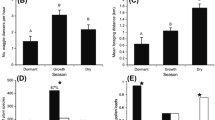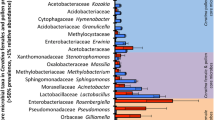Abstract
Bees forage for pollen and nectar at flowers but simultaneously acquire pathogenic, commensal, and likely beneficial microbes from these same flowers. Characterizing pollen usage of wild bees is therefore crucial to their conservation yet remains a challenging task. To understand pollen usage across landscapes and how this affects microbial communities found in the pollen provisions collected from flowers, we studied the generalist small carpenter bee Ceratina australensis. We collected C. australensis nests from three different climatic zones across eastern and southern Australia. To characterize the plant, fungal, and bacterial composition of these pollen provisions, we used a metabarcoding and next-generation sequencing approach. We found that the species richness of plant types, fungi, and bacteria was highest in a subtropical zone compared to a temperate or a grassland zone. The composition of these communities also differentiated by zone, particularly in pollen composition and fungal communities. Moreover, pollen composition strongly correlated with fungal community composition, suggesting that variation in pollen usage across landscapes results in variation in microbial communities. While how these pollen usage and microbial community patterns affect bee health merits additional work, these data further our understanding of how flowering plant community composition affects not only the pollen usage of a generalist bee but also its associated microbial communities.



Similar content being viewed by others
References
Beil M, Horn H, Schwabe A (2008) Analysis of pollen loads in a wild bee community (Hymenoptera: Apidae)—a method for elucidating habitat use and foraging distances. Apidologie 39:456–467
Adler LS, Irwin RE (2006) Comparison of pollen transfer dynamics by multiple floral visitors: experiments with pollen and fluorescent dye. Ann Bot 97:141–150. https://doi.org/10.1093/aob/mcj012
Jha S, Kremen C (2013) Resource diversity and landscape-level homogeneity drive native bee foraging. Proc Natl Acad Sci U S A 110:555–558. https://doi.org/10.1073/pnas.1208682110
Roulston TH, Cane JH (2002) The effect of pollen protein concentration on body size in the sweat bee Lasioglossum zephyrum (Hymenoptera: Apiformes). Evol Ecol 16:49–65. https://doi.org/10.1023/A:1016048526475
Tasei J-N, Aupinel P (2008) Nutritive value of 15 single pollens and pollen mixes tested on larvae produced by bumblebee workers (Bombus terrestris, Hymenoptera: Apidae). Apidologie 39:397–409. https://doi.org/10.1051/apido:2008017
Roger N, Michez D, Wattiez R et al (2017) Diet effects on bumblebee health. J Insect Physiol 96:128–133. https://doi.org/10.1016/j.jinsphys.2016.11.002
McFrederick QS, Thomas JM, Neff JL et al (2017) Flowers and wild megachilid bees share microbes. Microb Ecol 73:188–200. https://doi.org/10.1007/s00248-016-0838-1
Graystock P, Goulson D, Hughes WOH (2015) Parasites in bloom: flowers aid dispersal and transmission of pollinator parasites within and between bee species. Proc R Soc B Biol Sci 282:20151371. https://doi.org/10.1098/rspb.2015.1371
McArt SH, Koch H, Irwin RE, Adler LS (2014) Arranging the bouquet of disease: floral traits and the transmission of plant and animal pathogens. Ecol Lett 17:624–636. https://doi.org/10.1111/ele.12257
Roulston T, Goodell K (2010) The role of resources and risks in regulating wild bee populations. Annu Rev Entomol 56:293–312
Goulson D, Nicholls E, Botias C, Rotheray EL (2015) Bee declines driven by combined stress from parasites, pesticides, and lack of flowers. Science 347:1255957–1255957. https://doi.org/10.1126/science.1255957
Ginsberg HS (1983) Foraging ecology of bees in an old field. Ecology 64:165–175. https://doi.org/10.2307/1937338
Kitaoka TK, Nieh JC (2009) Bumble bee pollen foraging regulation: role of pollen quality, storage levels, and odor. Behav Ecol Sociobiol 63:501–510. https://doi.org/10.1007/s00265-008-0684-3
Cook SM, Sandoz JC, Martin AP et al (2005) Could learning of pollen odours by honey bees (Apis mellifera) play a role in their foraging behaviour? Physiol Entomol 30:164–174. https://doi.org/10.1111/j.1365-3032.2005.00445.x
Ruedenauer FA, Spaethe J, Leonhardt SD (2015) How to know which food is good for you: bumblebees use taste to discriminate between different concentrations of food differing in nutrient content. J Exp Biol 218:2233–2240. https://doi.org/10.1242/jeb.118554
Hopkins CY, Jevans AW, Boch R (1969) Occurrence of octadeca-trans-2, cis-9, cis-12-trienoic acid in pollen attractive to the honey bee. Can J Biochem 47:433–436
Kapheim KM, Bernal SP, Smith AR et al (2011) Support for maternal manipulation of developmental nutrition in a facultatively eusocial bee, Megalopta genalis (Halictidae). Behav Ecol Sociobiol 65:1179–1190. https://doi.org/10.1007/s00265-010-1131-9
Kapheim KM, Nonacs P, Smith AR et al (2015) Kinship, parental manipulation and evolutionary origins of eusociality. Proc R Soc B Biol Sci 282:20142886. https://doi.org/10.1086/340600
Lawson SP, Helmreich SL, Rehan SM (2017) Effects of nutritional deprivation on development and behavior in the subsocial bee Ceratina calcarata (Hymenoptera: Xylocopinae). J Exp Biol 220:4456–4462. https://doi.org/10.1242/jeb.160531
Lawson SP, Ciaccio KN, Rehan SM (2016) Maternal manipulation of pollen provisions affects worker production in a small carpenter bee. Behav Ecol Sociobiol 70:1891–1900. https://doi.org/10.1007/s00265-016-2194-z
Durrer S, Schmid-Hempel P (1994) Shared use of flowers leads to horizontal pathogen transmission. Proc R Soc B Biol Sci 258:299–302
Evison SEF, Roberts KE, Laurenson L et al (2012) Pervasiveness of parasites in pollinators. PLoS One 7:e30641. https://doi.org/10.1371/journal.pone.0030641
McFrederick QS, Wcislo WT, Taylor DR et al (2012) Environment or kin: whence do bees obtain acidophilic bacteria? Mol Ecol 21:1754–1768. https://doi.org/10.1111/j.1365-294X.2012.05496.x
McFrederick QS, Mueller UG, James RR (2014) Interactions between fungi and bacteria influence microbial community structure in the Megachile rotundata larval gut. Proc R Soc B Biol Sci 281:20132653
McFrederick QS, Rehan SM (2016) Characterization of pollen and bacterial community composition in brood provisions of a small carpenter bee. Mol Ecol 25:2302–2311. https://doi.org/10.1111/mec.13608
McFrederick QS, Cannone JJ, Gutell RR et al (2013) Specificity between lactobacilli and hymenopteran hosts is the exception rather than the rule. Appl Environ Microbiol 79:1803–1812. https://doi.org/10.1128/AEM.03681-12
Dew RM, Rehan SM, Schwarz MP (2016) Biogeography and demography of an Australian native bee Ceratina australensis (Hymenoptera, Apidae) since the last glacial maximum. J Hymenopt Res 49:25–41. https://doi.org/10.3897/JHR.49.8066
Engel P, James RR, Koga R et al (2013) Standard methods for research on Apis mellifera gut symbionts. J Apic Res 52:1–24. https://doi.org/10.3896/IBRA.1.52.4.07
Hawkins J, de Vere N, Griffith A et al (2015) Using DNA metabarcoding to identify the floral composition of honey: a new tool for investigating honey bee foraging preferences. PLoS One 10:e0134735. https://doi.org/10.1371/journal.pone.0134735
Smith DP, Peay KG (2014) Sequence depth, not PCR replication, improves ecological inference from next generation DNA sequencing. PLoS One 9:e90234. https://doi.org/10.1371/journal.pone.0090234
Rothman JA, Carroll MJ, Meikle WG et al (2018) Longitudinal effects of supplemental forage on the honey bee (Apis mellifera) microbiota and inter- and intra-colony variability. Microb Ecol 274:1–11. https://doi.org/10.1007/s00248-018-1151-y
Meeus I, De Graaf DC, Jans K, Smagghe G (2010) Multiplex PCR detection of slowly-evolving trypanosomatids and neogregarines in bumblebees using broad-range primers. J Appl Microbiol 109:107–115. https://doi.org/10.1111/j.1365-2672.2009.04635.x
Bourgeois AL, Rinderer TE, Beaman LD, Danka RG (2010) Genetic detection and quantification of Nosema apis and N. ceranae in the honey bee. J Invertebr Pathol 103:53–58. https://doi.org/10.1016/j.jip.2009.10.009
Caporaso JG, Kuczynski J, Stombaugh J et al (2010) QIIME allows analysis of high-throughput community sequencing data. Nat Methods 7:335–336
Callahan BJ, McMurdie PJ, Rosen MJ et al (2016) DADA2: high-resolution sample inference from Illumina amplicon data. Nat Methods 13:581–583. https://doi.org/10.1038/nmeth.3869
Quast C, Pruesse E, Yilmaz P et al (2013) The SILVA ribosomal RNA gene database project: improved data processing and web-based tools. Nucleic Acids Res 41:D590–D596. https://doi.org/10.1093/nar/gks1219
Abarenkov K, Henrik Nilsson R, Larsson K-H et al (2010) The UNITE database for molecular identification of fungi—recent updates and future perspectives. New Phytol 186:281–285. https://doi.org/10.1111/j.1469-8137.2009.03160.x
Bell KL, Loeffler VM, Brosi BJ (2017) An rbcL reference library to aid in the identification of plant species mixtures by DNA metabarcoding. Appl Plant Sci 5:1600110. https://doi.org/10.3732/apps.1600110
Cole JR, Wang Q, Cardenas E et al (2009) The ribosomal database project: improved alignments and new tools for rRNA analysis. Nucleic Acids Res 37:D141–D145. https://doi.org/10.1093/nar/gkn879
Altschul SF, Gish W, Miller W et al (1990) Basic local alignment search tool. J Mol Biol 215:403–410. https://doi.org/10.1006/jmbi.1990.9999
Atlas of Living Australia (2018) Available at: https://www.ala.org.au. Accessed 28 March 2018
Benjamini Y, Hochberg Y (1995) Controlling the false discovery rate: a practical and powerful approach to multiple testing. J Roy Stat Soc B Met 57:289–300
Mandal S, Van Treuren W, White RA et al (2015) Analysis of composition of microbiomes: a novel method for studying microbial composition. Microb Ecol Health Dis 26:27663
Oksanen J, Blanchet FG, Kindt R, et al (2017) vegan: community ecology package
Herrera CM, Pozo MI, Medrano M (2013) Yeasts in nectar of an early-blooming herb: sought by bumble bees, detrimental to plant fecundity. Ecology 94:273–279
Vannette RL, Fukami T (2017) Dispersal enhances beta diversity in nectar microbes. Ecol Lett 20:901–910
McFrederick QS, Vuong HQ, Rothman JA (2018) Lactobacillus micheneri sp. nov., Lactobacillus timberlakei sp. nov. and Lactobacillus quenuiae sp. nov., lactic acid bacteria isolated from wild bees and flowers. Int J Syst Evol Microbial 68:1879–1884. https://doi.org/10.1099/ijsem.0.002758
de Vega C, Herrera CM (2013) Microorganisms transported by ants induce changes in floral nectar composition of an ant-pollinated plant. Am J Bot 100:792–800
Rering CC, Beck JJ, Hall GW et al (2017) Nectar-inhabiting microorganisms influence nectar volatile composition and attractiveness to a generalist pollinator. New Phytol 40:6–12. https://doi.org/10.1111/nph.14809
Vannette RL, Fukami T (2016) Nectar microbes can reduce secondary metabolites in nectar and alter effects on nectar consumption by pollinators. Ecology 97:1410–1419. https://doi.org/10.1890/15-0858.1
Vannette RL, Gauthier M (2013) Nectar bacteria, but not yeast, weaken a plant–pollinator mutualism. Proc R Soc B Biol Sci 280:20122601. https://doi.org/10.1098/rspb.2012.2601
Herrera CM, García IM, Pérez R (2008) Invisible floral larcenies: microbial communities degrade floral nectar of bumble bee-pollinated plants. Ecology 89:2369–2376
Klinger EG, James RR, Youssef NN, Welker DL (2013) A multi-gene phylogeny provides additional insight into the relationships between several Ascosphaera species. J Invertebr Pathol 112:41–48. https://doi.org/10.1016/j.jip.2012.10.011
Batra L, Batra S, Bohart G (1973) The mycoflora of domesticated and wild bees (Apoidea). Mycopathologia 49:13–44
James RR, McGuire MR, Leland JE (2012) Susceptibility of adult alfalfa leafcutting bees and honey bees to a microbial control agent, Beauveria bassiana. Southwest Entomol 37:13–21. https://doi.org/10.3958/059.037.0102
Hammer TJ, Janzen DH, Hallwachs W et al (2017) Caterpillars lack a resident gut microbiome. Proc Natl Acad Sci U S A 114:9641–9646. https://doi.org/10.1073/pnas.1707186114
Ambika Manirajan B, Ratering S, Rusch V et al (2016) Bacterial microbiota associated with flower pollen is influenced by pollination type, and shows a high degree of diversity and species-specificity. Environ Microbiol 18:5161–5174. https://doi.org/10.1111/1462-2920.13524
Fridman S, Izhaki I, Gerchman Y, Halpern M (2011) Bacterial communities in floral nectar. Environ Microbiol Rep 4:97–104. https://doi.org/10.1111/j.1758-2229.2011.00309.x
McFrederick QS, Wcislo WT, Hout MC, Mueller UG (2014) Host species and developmental stage, but not host social structure, affects bacterial community structure in socially polymorphic bees. FEMS Microbiol Ecol 88:398–406. https://doi.org/10.1111/1574-6941.12302
Jojima Y, Mihara Y, Suzuki S (2004) Saccharibacter floricola gen. nov., sp. nov., a novel osmophilic acetic acid bacterium isolated from pollen. Int J Syst Evol Microbiol 54:2263–2267. https://doi.org/10.1099/ijs.0.02911-0
Lenaerts M, Lenaerts M, Álvarez-Pérez S et al (2014) Rosenbergiella australoborealis sp. nov., Rosenbergiella collisarenosi sp. nov. and Rosenbergiella epipactidis sp. nov., three novel bacterial species isolated from floral nectar. Syst Appl Microbiol 37:402–411. https://doi.org/10.1016/j.syapm.2014.03.002
Mendonça-Hagler LC, AHOS, 1993 (1993) Phylogeny of Metschnikowia species estimated from partial rRNA sequences. Int J Syst Bacteriol 43:368–373. https://doi.org/10.1099/00207713-43-2-368
Rosa CA, Lachance MA (1998) The yeast genus Starmerella gen. nov. and Starmerella bombicola sp. nov., the teleomorph of Candida bombicola (Spencer, Gorin & Tullock) Meyer & Yarrow. Int J Syst Bacteriol 48:1413–1417
Schaeffer RN, Mei YZ, Andicoechea J et al (2017) Consequences of a nectar yeast for pollinator preference and performance. Funct Ecol 31:613–621. https://doi.org/10.1111/1365-2435.12762
Rehan SM, Richards MH, Schwarz MP (2010) Social polymorphism in the Australian small carpenter bee, Ceratina (Neoceratina) australensis. Insect Soc 57:403–412. https://doi.org/10.1007/s00040-010-0097-y
Acknowledgements
We thank Wyatt Shell and Rebecca Dew (UNH) for assistance with nest collections as well as Laura Leger (UCR) for assistance with pathogen screens.
Funding
US Department of Agriculture NIFA Hatch funds (CA-R-ENT-5109-H) to QSM and (NC1173) to SMR, National Science Foundation MSB-ECA award #1638728 to QSM and National Science Foundation IOS-Behavior #1456296 to SMR, as well as National Geographic (9659-15) to SMR supported this research.
Author information
Authors and Affiliations
Corresponding author
Electronic Supplementary Material
ESM 1
(XLSX 465 kb)
Rights and permissions
About this article
Cite this article
McFrederick, Q.S., Rehan, S.M. Wild Bee Pollen Usage and Microbial Communities Co-vary Across Landscapes. Microb Ecol 77, 513–522 (2019). https://doi.org/10.1007/s00248-018-1232-y
Received:
Accepted:
Published:
Issue Date:
DOI: https://doi.org/10.1007/s00248-018-1232-y




